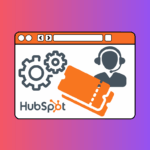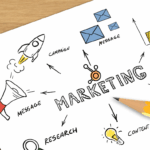
HubSpot Lead Nurturing Made Easy: A Practical Workflow Build Guide
Are your hard-earned leads going cold? Struggling to convert Marketing Qualified Leads (MQLs) into Sales Qualified Leads (SQLs)? You’re not alone.
In today’s competitive landscape, simply capturing leads isn’t enough. You need to cultivate those relationships, providing value and guidance until your prospects are genuinely ready to buy. That’s where lead nurturing comes in, and with HubSpot’s powerful Marketing Hub, it’s more accessible and effective than ever.
What is Lead Nurturing?
At its core, lead nurturing is the art and science of building meaningful relationships with your leads at every stage of their buyer’s journey. It’s about providing them with the right information, at the right time, through relevant channels. Think of it as guiding a seed – you don’t expect it to sprout overnight. It needs consistent care, the right amount of water and sunlight, to eventually blossom. Similarly, your leads need consistent engagement and valuable content to mature into paying customers.
Why is it Crucial?
Investing in a solid lead nurturing strategy yields significant benefits for your marketing and sales efforts:
- Increased Conversion Rates: By providing targeted content that addresses their specific needs and pain points, you increase the likelihood of leads converting into customers.
- Shorter Sales Cycles: Nurtured leads are often more informed and engaged, leading to a faster and smoother transition through the sales process.
- Building Trust and Credibility: Consistent delivery of valuable content positions your company as a trusted advisor and industry expert.
- Improved Lead Quality: Nurturing helps to filter out less engaged leads, allowing your sales team to focus on prospects who are genuinely interested and qualified.
- Maximizing Marketing ROI: By effectively moving leads through the funnel, you get more value from your lead generation efforts.
Why HubSpot for Lead Nurturing?
HubSpot’s Marketing Hub is a powerhouse for lead nurturing, offering a seamlessly integrated platform with the tools you need to succeed:
- Automation Capabilities (Workflows): Automate your nurturing sequences, ensuring timely and consistent communication without manual effort.
- Personalization Features: Tailor your messaging to resonate with individual leads based on their behavior, demographics, and interests.
- Integrated CRM: Gain a holistic view of your leads’ interactions, allowing for more informed and personalized nurturing.
- Tracking & Analytics: Monitor the performance of your nurturing efforts, identify areas for improvement, and measure your ROI.
What You’ll Learn:
This blog post will serve as your practical guide to building a foundational lead nurturing workflow within HubSpot. We’ll walk you through the essential steps, from planning your strategy to setting up your workflow and measuring its success. Let’s dive in!
Laying the Groundwork: Before You Build the Workflow
Before you jump into HubSpot and start dragging and dropping actions, it’s crucial to lay a solid foundation. Consider these key elements:
A. Define Your Goal: What specific outcome do you want from this particular workflow? Be precise. Examples include:
- Educating leads about a specific product feature.
- Encouraging leads who downloaded an ebook to request a demo.
- Moving MQLs to the Sales Qualified Lead (SQL) stage.
- Re-engaging inactive leads in your database.
Having a clear goal will dictate the content, timing, and calls to action within your workflow.
B. Identify Your Target Segment: Who are you trying to reach with this workflow? Understanding your audience is paramount for delivering relevant and engaging content. Consider factors like:
- Leads who downloaded a specific ebook or resource.
- Leads in a particular industry or with a specific job title.
- Leads who have shown interest in a specific product or service (e.g., visited the pricing page).
HubSpot Context: Leverage Lists (both Active and Static) within HubSpot to segment your audience effectively. Active lists dynamically update based on defined criteria, while static lists are fixed snapshots of contacts.
C. Map Your Content: What emails or offers will you deliver to nurture your target segment towards your defined goal? Outline the sequence of your communication:
- Email 1: Often focuses on reinforcing the value of the initial interaction (e.g., the downloaded ebook) and introduces a related, valuable resource.
- Email 2: Could feature a case study or testimonial showcasing how others have benefited from your offering.
- Email 3: Might include a softer call to action, such as inviting them to a relevant webinar or offering a helpful guide.
- Email 4 (and beyond): Can progress towards a more direct call to action, like requesting a demo or consultation.
Ensure that each piece of content logically follows the previous one and aligns with the lead’s presumed stage of interest.
HubSpot Context: Have your marketing emails drafted (or at least outlined with key talking points and calls to action) within HubSpot’s Email tool before building your workflow. This will streamline the building process.
D. Determine Enrollment Criteria (Triggers): How will contacts enter this nurturing workflow? This is a crucial step in HubSpot. Common triggers include:
- Form Submission: When a lead fills out a specific form on your website.
- List Membership: When a contact is added to a specific HubSpot list (based on segmentation).
- Property Value Change: When a specific contact property is updated (e.g., their Lifecycle Stage changes to MQL).
- Page View: When a contact visits a specific page on your website.
Choose the trigger(s) that best align with your target segment and the goal of your workflow.
E. Define Success/Exit Criteria: When should a contact be considered “nurtured” and exit the workflow? Defining clear success criteria is essential for accurate reporting and preventing over-communication. Examples include:
- They achieve the workflow’s goal (e.g., book a demo).
- They become a customer (Lifecycle Stage = Customer).
- They reply to one of your nurturing emails, indicating direct engagement.
- They explicitly opt-out of marketing emails.
Building Your Lead Nurturing Workflow in HubSpot: Step-by-Step
Now that you’ve laid the groundwork, let’s get into the practical steps of building your workflow in HubSpot:
A. Navigate to Workflows:
- In your HubSpot portal, navigate to Automation in the main menu.
- Select Workflows.
- Click the Create workflow button in the upper right corner.
- Choose Start from scratch and then select Contact-based as the workflow type.
B. Set Enrollment Triggers:
Click Set up triggers.
In the right-hand panel, choose the trigger type that you defined in your planning (e.g., “List memberships,” “Form submissions”).
Select the specific list, form, or property criteria. For example, if you chose “Form submissions,” select the specific form your leads fill out.
Click Apply filter.
Tip: For basic nurturing workflows, you’ll typically want to keep the re-enrollment options turned off to avoid sending the same nurture sequence multiple times to the same contact.
C. Add Actions: The Core Sequence:
- Click the “+” (plus) icon below the enrollment trigger to add your first action.
- Action 1: Delay: This is crucial! Give your leads some time after the initial interaction before sending the first nurturing email. Select Delay and set an appropriate time (e.g., 1-2 days). Click Save.
- Click the “+” icon below the delay.
- Action 2: Send Email: Select Send email and choose the first marketing email you prepared. Click Save.
- Click the “+” icon below the email action.
- Action 3: Delay: Add another Delay for an appropriate duration (e.g., 3-5 days) before the next email. Click Save.
- Click the “+” icon below the delay.
- Action 4: Send Email: Select Send email and choose your second email. Click Save.
- Repeat the Delay and Send Email actions to build out the rest of your planned email sequence. Ensure the delays between emails are logical and provide sufficient time for leads to engage with the content.
D. Incorporate Simple Logic (Optional but Recommended):
Adding basic logic can significantly enhance the effectiveness of your nurturing:
- If/Then Branches: Click the “+” icon and select If/then branch. You can create branches based on a contact’s engagement with your emails (e.g., “Did contact click link in Email 2?”).
- Yes Path: You might send a more targeted email with a stronger call to action or even trigger a notification for your sales team.
- No Path: You could continue with the standard nurture sequence or try a different angle in your subsequent emails.
- Update Property: Use the Set property value action to update a contact property based on their behavior in the workflow. For example, you could update a custom “Nurture Status” property or increment their Lead Score based on email clicks or form submissions.
E. Set a Workflow Goal (Crucial for Reporting):
Click Set goal at the top of the workflow builder.
Define the criteria that signifies a successful outcome for this workflow. This should align with the goal you defined earlier (e.g., Contact property: Lifecycle Stage is SQL, Form submission: Demo Request Form).
Click Save.
Contacts who meet the goal criteria will be automatically unenrolled from the workflow, preventing further nurturing for that specific goal.
F. Configure Settings:
- Click the Settings tab at the top of the workflow builder.
- Unenrollment and Suppression Lists: Review the default settings and add any lists of contacts you want to automatically unenroll or suppress from this workflow (e.g., existing customers, unsubscribed contacts).
- Execution Settings: If necessary, you can set specific days and times when the workflow actions should execute (e.g., only send emails during business hours).
- Workflow Name: Give your workflow a clear and descriptive name so you can easily identify it later (e.g., “Ebook Download Nurture – Demo Request Goal”).
G. Test Your Workflow:
- Before activating your workflow, thoroughly test it! Click the Test tab.
- Enroll an internal test contact that meets your trigger criteria.
- Monitor the contact’s activity within the workflow to ensure the triggers, delays, emails, and any logic you implemented are working as expected.
H. Review and Activate:
- Once you’re confident that your workflow is set up correctly, go back to the Review tab.
- Double-check all your triggers, actions, goals, and settings.
- If everything looks good, click the Turn on button in the upper right corner!
Best Practices for Effective HubSpot Nurturing
Building the workflow is just the first step. To truly excel at lead nurturing in HubSpot, keep these best practices in mind:
- Personalization: Go beyond basic name merges. Use personalization tokens to address leads by their first name, company name, and other relevant properties. Consider using dynamic content to show different content blocks based on a contact’s properties or list memberships.
- Segmentation: Avoid creating one massive, generic nurturing workflow. Segment your audience based on their interests, behavior, and where they are in the buyer’s journey to deliver highly targeted and relevant content.
- Value First: Every email in your nurture sequence should provide genuine value to the recipient. Focus on educating, informing, and helping them solve their challenges, rather than just pushing your product or service.
- Clear CTAs: Make it obvious what you want the lead to do next. Use clear and concise calls to action (e.g., “Download the Guide,” “Watch the Demo,” “Schedule a Consultation”).
- Timing is Key: Don’t overwhelm your leads with too many emails too quickly. Space out your communications appropriately to allow them time to digest the information and engage.
- Sales Alignment: Keep your sales team informed about highly engaged leads within your nurturing workflows. Use internal email notifications or create tasks for sales reps when a lead reaches a certain engagement level or achieves a workflow goal.
- Mobile Optimization: Ensure all your marketing emails are responsive and look great on all devices, as many people will be viewing them on their phones or tablets.
Measuring Success and Optimizing Your Workflow
Once your workflow is live, it’s crucial to monitor its performance and make adjustments as needed:
- HubSpot Performance Tab: Within the workflow tool, navigate to the Performance tab to track key metrics such as delivery rate, open rate, click-through rate (CTR), goal conversion rate, and unsubscribes.
- Analyze Bottlenecks: Identify where leads are dropping off in your workflow. Are certain emails underperforming? Is there a significant drop-off before a key call to action?
- A/B Test Emails: Use HubSpot’s A/B testing feature for emails within your workflow to experiment with different subject lines, content, and calls to action to see what resonates best with your audience.
- Iterate: Lead nurturing is not a “set it and forget it” activity. Continuously analyze your data and make adjustments to your delays, content, logic, and goals based on performance.
Conclusion
Building effective lead nurturing workflows in HubSpot doesn’t have to be complicated. By following this practical guide, you can create a foundational system that helps you cultivate relationships with your leads, improve lead quality, and ultimately drive more sales. Remember to define your goals, understand your audience, provide value, and continuously optimize your efforts.
Ready to transform your lead generation efforts? Start building your first HubSpot lead nurturing workflow today! Have questions? Share them in the comments below. And be sure to explore the more advanced automation features HubSpot offers to take your lead nurturing to the next level.
Have questions? We'd love to chat! Book your call today.
Resources:
- HubSpot Knowledge Base – Create and manage lists: https://knowledge.hubspot.com/lists/create-active-or-static-lists
- HubSpot Knowledge Base – Create and send marketing emails: https://knowledge.hubspot.com/marketing-email/create-and-send-marketing-emails-with-the-updated-classic-editor
- HubSpot Knowledge Base – Workflow enrollment triggers: https://knowledge.hubspot.com/workflows/set-your-workflow-enrollment-triggers
- HubSpot Knowledge Base – Getting started with workflows: https://knowledge.hubspot.com/workflows/create-workflows
- HubSpot Knowledge Base – Using delay actions in workflows: https://knowledge.hubspot.com/workflows/use-delays
- HubSpot Knowledge Base – Send email action in workflows: https://knowledge.hubspot.com/marketing-email/create-automated-emails-to-use-in-workflows
- HubSpot Knowledge Base – Use if/then branches in workflows: https://knowledge.hubspot.com/workflows/use-if-then-branches-in-workflows
- HubSpot Knowledge Base – Set property values in workflows: https://knowledge.hubspot.com/workflows/choose-your-workflow-actions
- HubSpot Knowledge Base – Set workflow goals: https://knowledge.hubspot.com/workflows/use-goals-in-contact-based-workflows
- HubSpot Knowledge Base – Manage workflow settings: https://knowledge.hubspot.com/workflows/manage-your-workflow-settings
- HubSpot Knowledge Base – Test your workflows: https://knowledge.hubspot.com/workflows/test-your-workflow
- HubSpot Knowledge Base – Analyze workflow performance: https://knowledge.hubspot.com/workflows/review-your-workflow-actions-aggregate-performance
- HubSpot Knowledge Base – A/B test a marketing email: https://knowledge.hubspot.com/marketing-email/run-an-a/b-test-on-your-marketing-email



